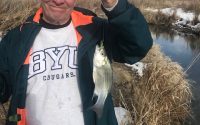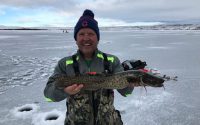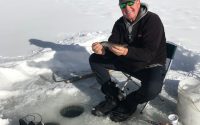Sand Hollow in the Winter?

A reader asks: “I don’t want to go ice fishing and will be in the St. George area for the month of February … can I catch fish at Sand Hollow in the winter?”
While it is true that Sand Hollow Reservoir doesn’t freeze, the water cools to the mid to low 40s this time of year. And, since it is a “warm water fishery” the fish (which include largemouth bass, crappies, and blue gills) are somewhat subdued and don’t eat nearly as often as they would during other times of the year.
Although fishing definitely slows during winter, there are still fish to be caught, and with a dose of patience combined with some warm clothing and access to a boat, you should be able to catch some quality largemouth bass.
I don’t have too much success with crappies or blue gills in the winter but the largemouth can be quite active at certain times a day. Allow me to take you through an example trip to Sand Hollow in February.
Plan your Trip
The first thing I do is check the water level in the reservoir and the surface temperature. This can be done by calling the Sand Hollow State Park at (435) 680-0715. The purpose is to determine if the water is rising or falling and to determine if the water temperature is stable or still moving lower.
With this information I plan my trip on days when high pressure dominates the weather. In fact, I try to time trips to begin on the third day after a cold front, and on a day that is expected to warm the air temperature to (at least) the 50s by early afternoon.
The day begins close to 7:00 a.m. (which is when the park gates open). After launching, the first area to look for fish would be directly across the reservoir from the ramp in a place called “pump house cove.” Just a few hundred yards south of the dam, pump house cove is a large flat that gradually drops into deeper and deeper water over the course of a couple of hundred yards.
Where to find the Fish and How to Catch Them
Since the water is cold (generally in the low to mid-40s) the bass will be in the grass on the bottom of the reservoir. I will use two specific methods and lures to catch these bass. The first is a 3/8-ounce blue gill or crawdad-colored jig. Compact jigs work better in the winter than larger, heavier jigs. I move the jig slowly along the bottom through the grass and expect a “thump,” when it is picked up by a bass hiding in the grass. Water depths from 20 to 35 feet should hold significant numbers of bass so when fishing jigs, I don’t really use my fish finder because I cast as far away from the boat as possible. Each cast can take as long as three to four minutes to complete, and patience is the key to success.
The second method is a drop shot (the weight is on the bottom and the hook is tied 18 to 24 inches above the weight on the main line). The bait would be a 4-inch finesse worm in variations of green, brown, blue, or purple. This is a time I “live” on my fish finder, drop down directly below the boat and allow the rig to rest on the bottom near the fish showing on my finder. Even with fish on the screen, it takes time to get them to bite.
After pump house cove, I move south and find 20 to 40 feet of water towards the middle of the reservoir and repeat the same two methods. As the day warms, more fish will become active and will hopefully bite.
I plan to catch at least 12 fish on a typical day described above but would be happy with reaching double digits. Fishing Sand Hollow in February is a very good decision. Good Luck!










